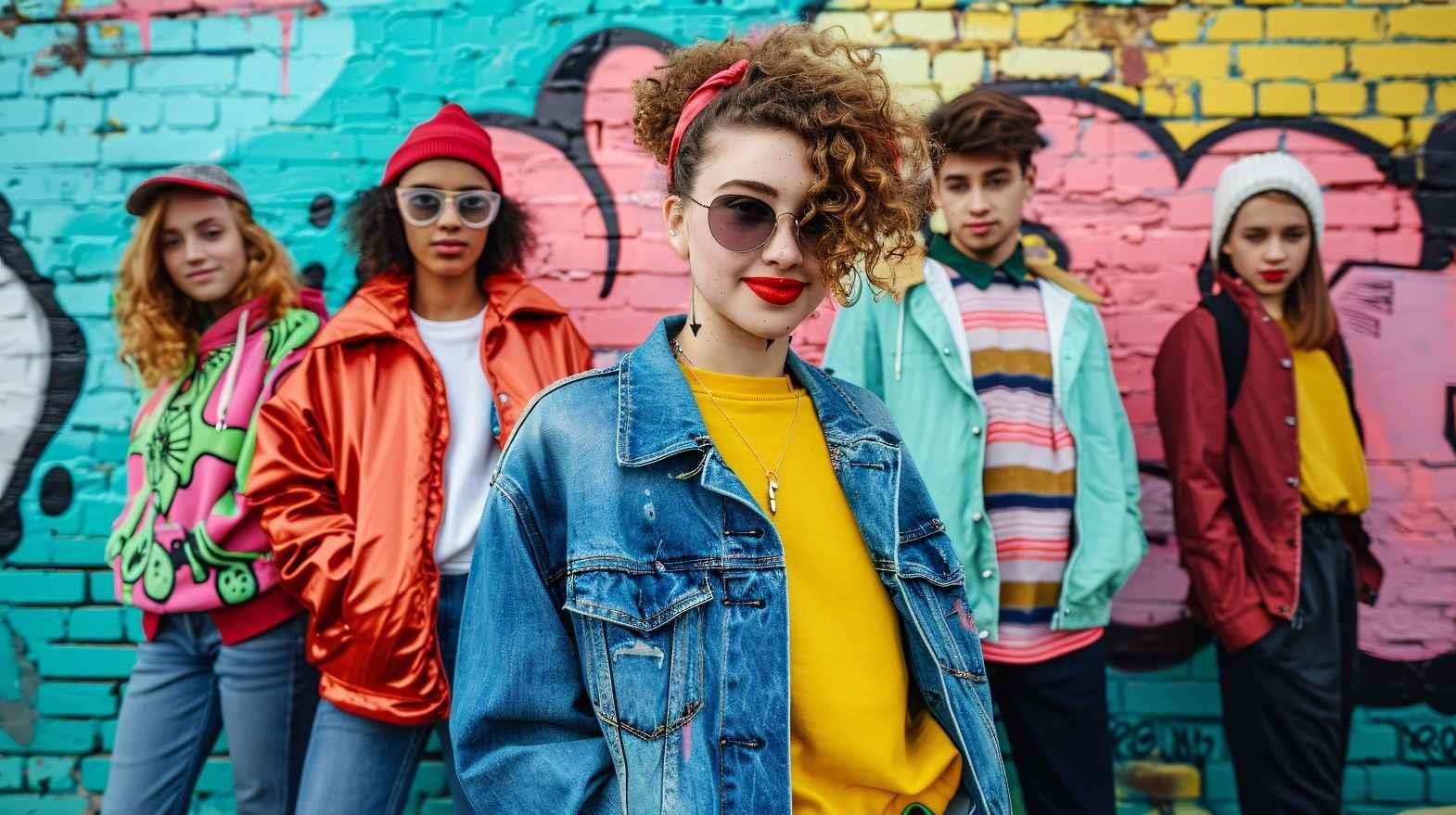Streetwear has undergone a tremendous transformation in recent years, evolving from its modest beginnings to become a major force in high fashion. Once an underground subculture, streetwear has transcended social and cultural divides to emerge as a global fashion phenomenon. Originally rooted in skateboarding, hip-hop, and graffiti, it has developed into a diverse and influential industry.
This shift has reshaped the way people view fashion, blurring the lines between luxury and street style. Streetwear, with its emphasis on comfort, individuality, and self-expression, continues to captivate fashion enthusiasts worldwide. As its popularity grew, the boundaries between casual and high fashion blurred, attracting the attention of influential designers and luxury brands. Collaborations between these brands and streetwear labels brought the subculture into the mainstream.
Today, streetwear remains a driving force in the fashion industry, symbolising self-expression and cultural identity for a diverse global audience. The rise of social media and digital culture has further accelerated its growth, allowing it to continually evolve and reach new heights. Its enduring appeal keeps it at the forefront of fashion trends, representing a dynamic blend of past influences and future possibilities.
The Roots of Streetwear
Streetwear began in the 1970s in California, where surfers and skaters needed practical and comfortable clothing for their activities. It emerged during the late 20th century as a symbol of self-expression, creativity, and individuality, evolving from a fusion of urban subcultures, particularly skateboarding and hip-hop. These movements, known for their rebellious and nonconformist attitudes, created the perfect environment for a new fashion style that emphasised comfort, self-expression, and a do-it-yourself (DIY) ethos.
The 1980s saw the rise of streetwear brands like Shawn Stussy’s label, Stussy1. Initially selling custom surfboards, Stussy expanded into apparel, featuring his distinctive signature logo on T-shirts, hoodies, and caps. This simple yet impactful branding resonated with both surfers and skaters, laying the foundation for a global fashion movement. Stussy heightened its exclusivity by introducing custom-made Varsity jackets, available only to those closely associated with the brand, such as designers, photographers, and store managers. These special jackets, featuring the recipient’s name and the phrase “International Stussy Tribe”, helped the brand maintain its unique identity and avoid becoming just another mass-market label.
Simultaneously, the hip-hop scene was flourishing in New York City, where artists and their fans developed a distinctive style of oversized shirts, baggy jeans, and bold accessories, reflecting the music’s raw, street-level origins. Global brands like Adidas and Nike, already popular with athletes, gained new followers among the youth who embraced hip-hop culture. A notable example is Run-D.M.C.’s endorsement of Adidas sneakers2 in the mid-1980s, which highlighted the growing connection between music and fashion in streetwear’s early days.
In the 1990s, streetwear expanded further with the rise of brands like Supreme in New York and A Bathing Ape (BAPE) in Japan. Founded by James Jebbia in 1994, Supreme began as a skate shop and quickly gained a following due to its limited-edition releases and collaborations with artists and other brands. Meanwhile, Nigo, who founded BAPE in 1993, brought a unique Japanese approach to streetwear, combining Western influences with bold, distinctive designs.
These early streetwear pioneers set the standard by blending exclusivity, artistic partnerships, and cultural relevance. By the late 1990s and early 2000s, streetwear had grown from a niche subculture into a global movement, impacting mainstream fashion and continually adapting to the changing landscape of urban culture.
The Cultural Impact of Streetwear
At its core, streetwear prioritises comfort and practicality, often featuring oversized silhouettes, graphic T-shirts, hoodies, sneakers, and baseball caps. Graffiti artists played a significant role in its development, using streetwear as a canvas for their creative expressions. More than just a fashion statement, streetwear became a means for individuals to showcase their uniqueness, creativity, and often a sense of rebellion.
A defining aspect of streetwear is its ability to merge high fashion with everyday wear. The 2000s and 2010s witnessed a rise in collaborations between luxury fashion houses and streetwear brands, such as Louis Vuitton x Supreme3 and Nike x Off-White4, which brought streetwear into the mainstream. These partnerships blurred the lines between casual and high-end fashion, reaching a broader audience and elevating streetwear’s status in the fashion world.
Streetwear is also deeply intertwined with music and popular culture. Influential artists and celebrities frequently endorse streetwear brands, further boosting their appeal. The rise of social media has significantly contributed to its spread, offering enthusiasts a platform to showcase their style and discover new trends globally.
Today, streetwear has evolved into a global phenomenon, transcending its subcultural origins to become a dominant force in the fashion industry. Its dynamic and ever-evolving nature continues to engage diverse audiences, solidifying its role as a powerful form of cultural expression and a key component of contemporary fashion.
Top Streetwear Essentials
Hoodies, T-shirts, and sneakers are among the most sought-after items in streetwear, valued for their versatility. These staples can be worn year-round, in almost any weather or setting. Not only are they comfortable, but they also serve as blank canvases for the printed and embroidered designs that define streetwear.
While T-shirts and hoodies are versatile, the market has become oversaturated with brands producing similar items. Sneakers, however, have taken on a role akin to accessories or fragrances in the broader fashion industry. Their appeal lies in their universal nature, blending design with a sense of nostalgia. For some, sneakers represent a connection to a sports team or a cherished childhood memory, while for others, they serve as a reflection of personal style. With sneakers available at various price points, they are accessible to a wide range of people, bridging different cultures and tastes.
According to a Streetwear Impact Report by Hypebeast5, footwear is the key driver of streetwear purchases. More than half (62 per cent) of consumers surveyed indicated that footwear was their top choice, followed by around one-third (30 per cent) who preferred tops, including T-shirts and hoodies. Only 6 per cent of respondents selected accessories.
Nearly half (45 per cent) of respondents stated they purchase streetwear items once a month, while a third (35 per cent) reported buying products every three months. Streetwear enthusiasts are drawn to affordable pieces that offer both versatility and rarity, frequently updating their wardrobes to satisfy their fashion cravings.
Streetwear Trends: Predictions for 2024 and Beyond
From the streets to the runways, 2024 has been a year of innovation, sustainability, and bold statements in streetwear.
1. Tech-Infused Apparel: In 2024 and beyond, the integration of technology into streetwear is set to become more widespread. Expect garments with scannable barcodes, interactive features, and smart fabrics that react to environmental changes. These innovations will enhance both the visual appeal and functionality of streetwear, offering a seamless blend of style and advanced technology.
2. Reinterpretation of Iconic Styles: Nostalgia will continue to be a key influence on streetwear trends, but designers are moving beyond simple recreations. Instead, they are offering modern reinterpretations of classic styles. Refreshed versions of ’90s grunge, early 2000s fashion, and other vintage looks will incorporate contemporary elements, evoking a nostalgic yet updated feel. The return of rhinestones, exemplified by Ed Hardy’s revival, and retro embellishments like nailheads, will further contribute to this fusion of old and new.
3. Focus on Sustainability: The increasing focus on sustainability is significantly impacting streetwear. Collections will feature eco-friendly materials, recycled fabrics, and ethical manufacturing practices. Brands that emphasise environmental stewardship and social responsibility will stand out, as consumers increasingly favour fashion that reflects their values. This shift aligns with broader environmental goals and encourages innovation in materials and production methods.
4. Surge in Gender-Fluid Designs: The rise of gender-fluid designs is reshaping streetwear, reflecting a broader cultural shift towards inclusivity and self-expression. Brands are embracing designs that transcend traditional gender norms, offering versatile pieces with adaptable silhouettes, neutral colour palettes, and unisex fits. This trend challenges conventional boundaries, promoting a more progressive approach to fashion and setting new standards for diversity and acceptance.
5. Demand for Customised Fashion Experiences: The growing desire for distinctive and personalised fashion is leading to an increase in customisable streetwear. Brands will offer more options for consumers to tailor their garments, including choices in colours, fabrics, and personalised embroidery or prints. This trend caters to the demand for individuality in an era dominated by mass-produced items.
6. Virtual Street Fashion Experiences: As the metaverse becomes a larger part of everyday life, virtual fashion experiences are emerging as a prominent trend in streetwear. Digital fashion shows and virtual try-on applications will create a seamless connection between the physical and digital realms, offering consumers new and immersive ways to engage with streetwear. Brands like ASOS6 are already enhancing their e-commerce platforms by integrating video content and virtual size assistants, helping customers make more informed choices without physically trying on garments.
7. Athleisure Dominance: The athleisure trend continues to grow, blending sportswear-inspired items with streetwear. Oversized hoodies, track pants, and innovative fabrics seamlessly blend comfort with style, becoming key elements of everyday fashion. As athleisure evolves, expect further innovations in fabric technology and design, offering even more versatility and functionality.
8. Community and Collaboration: Streetwear has always been rooted in community and collaboration, and this focus will only grow stronger in the future. Expect more partnerships between brands, artists, and influencers, as well as deeper engagement with fan communities and subcultures. These collaborations bring fresh, innovative ideas while strengthening connections with audiences. As streetwear evolves, brands will increasingly work with their followers, listen to their feedback, and develop collections that reflect the diverse cultures and communities shaping the movement.
Ending Note
Streetwear’s evolution into high fashion marks a significant shift in the industry, challenging traditional notions of luxury, style, and status. Once a grassroots movement from urban subcultures, streetwear has become a global force, influencing how people dress, shop, and engage with fashion. Its rise from the margins to the centre of the fashion world highlights its profound impact, reflecting broader changes in consumer attitudes, where individuality and authenticity are valued over exclusivity.
The blending of streetwear with high fashion bridges diverse fashion worlds, promoting a more inclusive and innovative industry. Looking ahead, streetwear’s influence will continue to grow, with ongoing innovation, collaborations, and cultural significance. Whether seen on the streets or the runways, streetwear remains a powerful form of self-expression, reflecting the dynamic nature of modern style and identity. As it adapts to new trends and technologies, streetwear will continue to shape the future of fashion and inspire creativity for years to come.









Comments